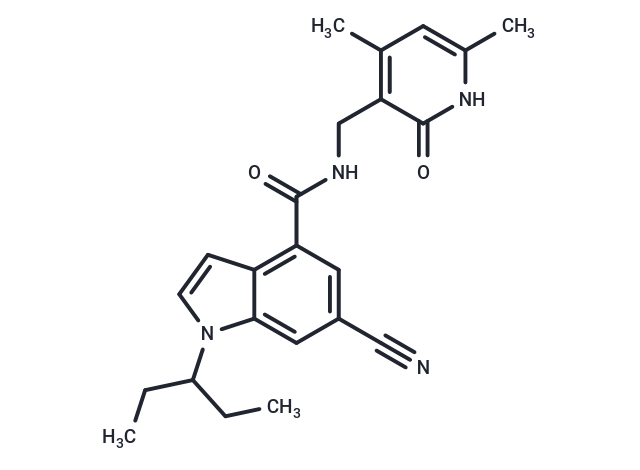Shopping Cart
- Remove All
 Your shopping cart is currently empty
Your shopping cart is currently empty

EI1 (Ezh2 inhibitor) is a potent and selective EZH2 inhibitor with IC50 of 15 nM and 13 nM for EZH2 (WT) and EZH2 (Y641F), respectively.

| Pack Size | Price | Availability | Quantity |
|---|---|---|---|
| 5 mg | $38 | In Stock | |
| 10 mg | $59 | In Stock | |
| 25 mg | $116 | In Stock | |
| 50 mg | $172 | In Stock | |
| 100 mg | $253 | In Stock | |
| 200 mg | $377 | In Stock | |
| 1 mL x 10 mM (in DMSO) | $43 | In Stock |
| Description | EI1 (Ezh2 inhibitor) is a potent and selective EZH2 inhibitor with IC50 of 15 nM and 13 nM for EZH2 (WT) and EZH2 (Y641F), respectively. |
| Targets&IC50 | EZH2 (Y641F):13 nM, EZH2 (WT):15 nM |
| In vitro | In DLBCL cells, EI1 inhibits cellular H3K27 methylation and activates Ezh2 target gene p16 expression. In mouse embryonic fibroblasts, EI1 also inhibit H3K27me3 and cell proliferation. In addition, EI1 selectively inhibits the growth of DLBCL cells carrying Ezh2 mutation, and causes cell cycle arrest and apoptosis. [1] |
| Kinase Assay | Biochemical Assay: For IC50 determination, EI1 is serial diluted threefold in DMSO for a total of 12 concentrations, with the starting concentration at 1 μM. The reaction is incubated at room temperature for 120 min, and stopped by adding quench solution (2.5% TFA with 320 nM d4-SAH). SAH production is quantitated using an API 4000 triple quadrupole mass spectrometry with Turbulon Spray coupled with Prominence UFLC. The percentage of inhibition is normalized using positive (no inhibitor) and negative (no enzyme) controls, and IC50 calculated using PRISM. Enzymology studies of S-Adenosyl methionine (SAM) competition are performed with slight modification of reaction condition: 10 μM EI1 is used as the starting dose for serial dilution. SAM is titrated over a range between 1 μM and 50 μM (corresponding to 1 × Km and 50 × Km), and substrate peptide is present in the final reaction mixture at its saturated condition (10 μM). For histone methyltransferase (HMT) profiling in Table 1, all HMTs are purified recombinant proteins from either Escherichia coli or Baculovirus system. The catalytic domain of G9a, SuV39H2, Set7/9, CARM1, SETD8, NSD3, SETD2, and Dot1L, and the full-length SmyD2 protein were used in the biochemical assays. HMT biochemical reactions are carefully characterized with enzymology studies and the SAM and substrate Km determined. The SAM and substrate concentrations are kept at their respective Km for most of the HMTs, except the ones (SmyD2 and Set7/9) with low SAM-Km value, for which 0.5 μM SAM is used. All HMT reactions are performed using the same assay format where the production of SAH from the biochemical reaction is quantitated by LC-MS. |
| Cell Research | Exponentially growing diffused large B-cell lymphoma (DLBCL) cells are seeded in 12-well plates at a density of 1 × 105 cells/mL with the indicated concentration of EI1. Viable cell number is determined every 3–4 d for up to 14 or 15 d by Vi-CELL. Mouse embryonic fibroblasts (MEFs) are seeded in a six-well plate at 2.5 × 104 cell/mL and treated with EI1 (3.3 μM) or 4-OH-tamoxifen (100 nM). Viable cell number is determined at days 3, 6 and 11. On days of cell counts, fresh growth medium and compound are replenished and cells split back to a density of 1 × 105 cells/mL. Total cell number is expressed as split-adjusted viable cells per milliliter. IC50 is calculated by PRISM and all proliferation experiments are repeated more than two times and representative data are presented.(Only for Reference) |
| Alias | KB-145943, Ezh2 inhibitor |
| Molecular Weight | 390.48 |
| Formula | C23H26N4O2 |
| Cas No. | 1418308-27-6 |
| Smiles | CCC(CC)n1ccc2c(cc(cc12)C#N)C(=O)NCc1c(C)cc(C)[nH]c1=O |
| Relative Density. | 1.20 g/cm3 (Predicted) |
| Storage | Powder: -20°C for 3 years | In solvent: -80°C for 1 year | Shipping with blue ice. | |||||||||||||||||||||||||
| Solubility Information | H2O: Insoluble DMSO: 12.5 mg/mL (32.01 mM), Sonication is recommended. | |||||||||||||||||||||||||
Solution Preparation Table | ||||||||||||||||||||||||||
DMSO
| ||||||||||||||||||||||||||

Copyright © 2015-2025 TargetMol Chemicals Inc. All Rights Reserved.